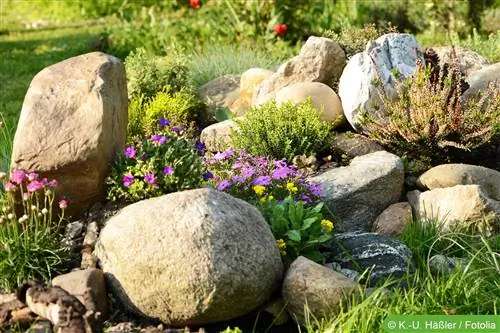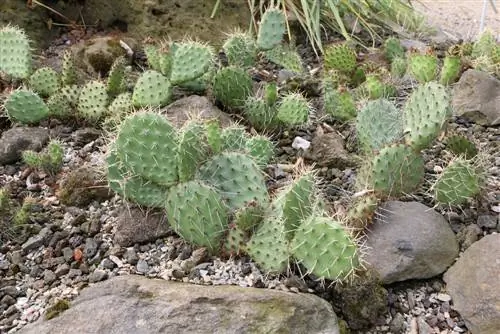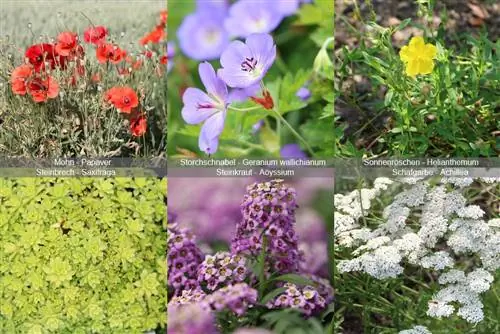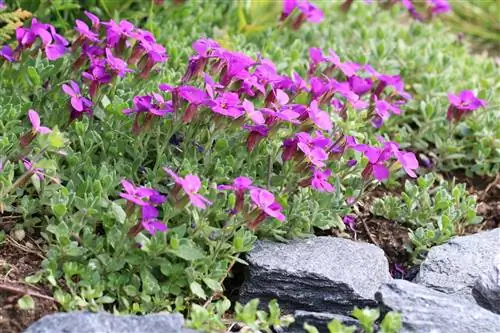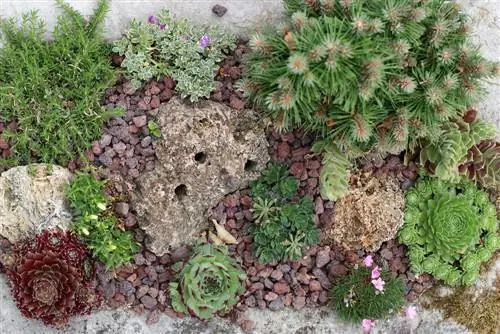- Author admin [email protected].
- Public 2023-12-17 03:39.
- Last modified 2025-01-24 12:45.
Rock gardens are considered particularly easy-care gardens that still impress with their very own charm. However, without plants, this rock garden appears cold and lifeless. Planting is therefore a key component when it comes to adding personal charm to a rock garden. Planting helps to bring variety to the stone landscape. However, the selection of plants should not be arbitrary.
Create your own rock garden in your home garden
In a rock garden, a layer of topsoil approximately 30 cm deep is removed. This area is covered with a fleece. This area is now filled up to 5 cm with a mixture of topsoil and gravel. The top layer is covered with the desired stones. The type of rock can be chosen according to personal preferences. However, only one type of rock should be selected here.
Selecting the right rock garden plants
A rock garden that is filled with too many different plants quickly appears restless and chaotic. To prevent this, it is better to choose a few plants. These can be arranged in larger groups to liven up the stone bed. In principle, it can be said that the smaller the rock garden, the fewer plants should be selected. For very small rock gardens, a maximum of three different evergreen and year-round plant species should be used. However, flower bulbs can be combined with this in spring. When choosing colors, care should be taken to ensure that the colors of the plants match each other. This limits the selection to a specific color, but allows maximum harmony to be created.
With evergreen plants, care should be taken to ensure that they are weatherproof and can overwinter. When selecting plants, however, care should be taken to determine which stones were used. In rock gardens in which sand-lime stone or dolomite was used, plants should be chosen that thrive on calcareous subsoil, as these stones often already contain lime. In contrast, granite, sandstone and bas alt, for example, are acidic or neutral. Almost all plants can be used with these types of rock.
The evergreen plants suitable for rock gardens
There is a huge selection of different types of plants that are suitable for planting in the rock garden. First of all, evergreen plants should be selected. The evergreen plants ensure that the rock garden looks lively even in winter. In addition, the roots of the evergreen plants also protect the soil from being eroded during heavy rainfall. When it comes to evergreen plants, however, care should be taken to ensure that they are small trees. Even if all of the evergreen plants are quite small when first planted, attention should be paid to the final size. Here, for example, dwarf trees can be used:
- Spherical pines look particularly beautiful in rock gardens. They grow bushy and sprawling and can be cut into a ball.
- The nest spruce, which is also easy to care for, resembles the round pines in its round growth.
- Small brooms can be used to add some yellow color during the flowering period.
- The five-finger bush can also bring color into play. However, since there are different colored variants, the color should be chosen to match the other plants in the rock garden.
- The roof root also brings color into play as a hardy plant in the months of July and August.
- Alpine azaleas can be used to bring the color lilac or rosé into play.
The rock daphne, dwarf conifers, the dwarf mountain pine, the hanging willow, the dwarf helmetlock firs and the creeping juniper are also suitable for planting in rock gardens.
Bulb and bulb plants for rock gardens
Tumer and bulbous plants should not be avoided in a rock garden. Their flowers can provide a colorful experience at different times of the year. Here you should make sure that the plants are chosen so that there are always some in bloom. Plants that bloom in spring should be combined with plants that bloom in autumn. One such plant is the autumn crocus, which is, however, very poisonous. Its flowering period is from August to October. An alternative to this is the autumn crocus, which not only looks very similar to the autumn crocus, but also blooms at the same time. In contrast, winter aconites bloom from January to March. Squills, tulips, daffodils, dwarf irises or crocuses can also be used.
Planting perennials in rock gardens
Perennials should definitely be combined with other plants in the rock garden. There is also a large selection of different perennials here:
This includes the cat's paw. This medicinal plant can be perfectly combined with other plants that are lilac in color.
- Small groups of lavender, for example, fit in here.
- In addition, cyclamen, primroses, edelweiss, gentian or bluebells are suitable for planting in the rock garden.
- Cushion perennials or alyssum can also be used.
- The rock garden can also be loosened up with grasses such as bluegrass or bear grass.
- Perennials such as alyssum, goose cress or starwort can provide variety in the rock garden.
In addition, the alpine alpine bells, the various types of sedum, the hunger flowers or sun roses can beautify the rock garden with their different colors. Particular attention should be paid to the color selection when it comes to perennials!
Rare and exotic plants for rock gardens
If you like something more exotic, i.e. if you want to fill your rock garden with plants that are not available everywhere, you will usually have to dig deeper into your pockets. In addition, these plants are often not available everywhere. One of the rarities is the dwarf schöterich, which impresses with its strong colors and beautiful flowers. In addition, beautiful orchid species in the stone bed can also be a real visual highlight. Here you can find special orchids such as the Tibet orchid or the bog orchid.
Ground cover for the rock garden
Classic rock garden plants are ground cover plants, i.e. plants that do not grow very tall and rather crawl over the ground. Beautiful ground cover plants include the cushion bellflower or the small evergreen. Of course there are many more. You can get the right plants or seedlings at any hardware store or gardening store. Advice is included here. So you should know whether the plants prefer to endure the sun or whether a location in the shade is planned.
You can also get the stones at the hardware store or from the farmer around the corner who collected the stones from the field. With great attention to detail you can then plan the rock garden and plant lots of rock flowers, blue fescues or carnations. To create a special highlight between your own rock garden plants, you could think about using bowls or troughs. A bird bath can then be quickly set up or a pot with spring bloomers placed between the stones. Certain jewelry, such as balls or terracotta animals, also look very nice in the well-kept rock garden.
What you should know about rock garden plants in brief
- The plants in a rock garden should not be too large, otherwise the character of the planting will be lost.
- If there is a lot of space and you use larger stones, the plants can also be a little larger.
- In the rock garden, no plants should be used that are overgrown and quickly spread uncontrollably.
- Rock garden plants can be found in nurseries, but also in garden centers and many suppliers can be found on the Internet.
Suitable trees are:
- Fan Maple
- Low Bell Hazel
- fingerbush
- Stone broom
- Refined Korean fir
- True Blue Fir
- numerous coniferous shrubs and small-leaved rhododendron species
- Cacti are also suitable if they are frost-resistant.
The following flowers are suitable:
- bellflowers that stay small
- Primroses
- Mountain carnations
- Gentian
- various roof root species
- many Sedum species
- Pasque Flower
- Hungerblümchen
- Cushion Asters
- Cat paws
- low sedums
- Columbine
- Balkan carnation
- Blue Fescue
- Blue pillow
- Spring Adonis Roses
- yellow-leaved dost
- Yellow Sunflower
- carpet phlox
- Godflower
- Heidennelke
- Caucasus goose cress
- Cornflower aster
- Pasqueflower
- Lily of the valley
- Mosquito grass
- Cushion carnations
- Stone purse
- Lunchflower
- Red Anthyll
- Rock Garden Cranesbill
- and many more.
Grasses are particularly beautiful in autumn. They retain their beauty well into fall and some are still pretty to look at even in winter. However, the grasses must not become too dominant or too large. In spring, bulbous plants, i.e. spring bloomers, are an eye-catcher in the rock garden. These shouldn't get too tall either, but there are an awful lot of small varieties, whether tulip, daffodil, crocus or others.

